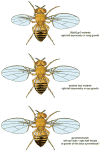The fly eye: Through the looking glass
- PMID: 28856763
- PMCID: PMC5746045
- DOI: 10.1002/dvdy.24585
The fly eye: Through the looking glass
Abstract
The developing eye-antennal disc of Drosophila melanogaster has been studied for more than a century, and it has been used as a model system to study diverse processes, such as tissue specification, organ growth, programmed cell death, compartment boundaries, pattern formation, cell fate specification, and planar cell polarity. The findings that have come out of these studies have informed our understanding of basic developmental processes as well as human disease. For example, the isolation of a white-eyed fly ultimately led to a greater appreciation of the role that sex chromosomes play in development, sex determination, and sex linked genetic disorders. Similarly, the discovery of the Sevenless receptor tyrosine kinase pathway not only revealed how the fate of the R7 photoreceptor is selected but it also helped our understanding of how disruptions in similar biochemical pathways result in tumorigenesis and cancer onset. In this article, I will discuss some underappreciated areas of fly eye development that are fertile for investigation and are ripe for producing exciting new breakthroughs. The topics covered here include organ shape, growth control, inductive signaling, and right-left symmetry. Developmental Dynamics 247:111-123, 2018. © 2017 Wiley Periodicals, Inc.
Keywords: Drosophila; eye; eye-antennal imaginal disc; peripodial epithelium; retina; shape; size; symmetry.
© 2017 Wiley Periodicals, Inc.
Figures






Similar articles
-
The role of Sevenless in Drosophila R7 photoreceptor specification.Dev Biol. 2019 Oct 15;454(2):181-189. doi: 10.1016/j.ydbio.2019.06.007. Epub 2019 Jun 14. Dev Biol. 2019. PMID: 31207209 Free PMC article.
-
Parsimony and complexity: Cell fate assignment in the developing Drosophila eye.Fly (Austin). 2017 Jul 3;11(3):171-178. doi: 10.1080/19336934.2017.1291103. Epub 2017 Feb 6. Fly (Austin). 2017. PMID: 28165886 Free PMC article.
-
Three distinct roles for notch in Drosophila R7 photoreceptor specification.PLoS Biol. 2011 Aug;9(8):e1001132. doi: 10.1371/journal.pbio.1001132. Epub 2011 Aug 23. PLoS Biol. 2011. PMID: 21886484 Free PMC article.
-
Signaling mechanisms in induction of the R7 photoreceptor in the developing Drosophila retina.Bioessays. 1994 Apr;16(4):237-44. doi: 10.1002/bies.950160406. Bioessays. 1994. PMID: 8031300 Review.
-
The sevenless signaling pathway: variations of a common theme.Biochim Biophys Acta. 2000 Apr 17;1496(2-3):151-63. doi: 10.1016/s0167-4889(00)00020-3. Biochim Biophys Acta. 2000. PMID: 10771085 Review.
Cited by
-
New regulators of Drosophila eye development identified from temporal transcriptome changes.Genetics. 2021 Apr 15;217(4):iyab007. doi: 10.1093/genetics/iyab007. Genetics. 2021. PMID: 33681970 Free PMC article.
-
Peripodial adherens junctions regulate Ajuba-Yorkie signaling to preserve fly eye morphology.Biol Open. 2023 Mar 15;12(3):bio059579. doi: 10.1242/bio.059579. Epub 2023 Mar 27. Biol Open. 2023. PMID: 36912729 Free PMC article.
-
Hippo pathway and Bonus control developmental cell fate decisions in the Drosophila eye.Dev Cell. 2023 Mar 13;58(5):416-434.e12. doi: 10.1016/j.devcel.2023.02.005. Epub 2023 Mar 2. Dev Cell. 2023. PMID: 36868234 Free PMC article.
-
Genetic interactions between Protein Kinase D and Lobe mutants during eye development of Drosophila melanogaster.Hereditas. 2019 Dec 19;156:37. doi: 10.1186/s41065-019-0113-9. eCollection 2019. Hereditas. 2019. PMID: 31889943 Free PMC article.
-
Collective behaviors of Drosophila-derived retinal progenitors in controlled microenvironments.PLoS One. 2019 Dec 13;14(12):e0226250. doi: 10.1371/journal.pone.0226250. eCollection 2019. PLoS One. 2019. PMID: 31835272 Free PMC article.
References
-
- Amore G, Casares F. Size matters: the contribution of cell proliferation to the progression of the specification Drosophila eye gene regulatory network. Dev Biol. 2010;344:569–577. - PubMed
-
- Auerbach C. The development of the legs, wings, and halteres in wild type and some mutant strains of Drosophila melanogaster. Trans R Soc Edin. 1936;LVIII(Part III, No. 27)
-
- Baena-Lopez LA, Baonza A, Garcia-Bellido A. The orientation of cell divisions determines the shape of Drosophila organs. Curr Biol. 2005;15:1640–1644. - PubMed
-
- Baker WK. A clonal system of differential gene activity in Drosophila. Dev Biol. 1967;16:1–17. - PubMed
Publication types
MeSH terms
Substances
Grants and funding
LinkOut - more resources
Full Text Sources
Other Literature Sources
Molecular Biology Databases

